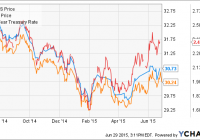TYNS Is An Inferior Inverse Bond ETF
Summary TYNS has very low AUM. TYNS is very illiquid. TYNS charges a fee that siphons off returns. Over the last month I have written extensively about inverse bond ETFs. Not all inverse bond ETFs are made equally though, so my goal is ultimately to dissuade investors from choosing low quality ETFs when there are superior options on the market. I believe we are in an economic environment unavoidably poised to experience rising interest rates. Inverse bond ETFs can be used shrewdly to capitalize on this market inevitability. Also, they can be used as hedging tools for bond heavy portfolios. However, there is long list of risks associated with investing in an inverse bond ETF, and it is prudent to research and analyze each security before investing. I believe inverse bond ETFs are valuable resources; however, it is important to know which inverse bond ETFs are the best in order to maximize returns. The Direxion Daily 7-10 Year Treasury Bear ETF (NYSEARCA: TYNS ) is inferior to the Proshares 7-10 Year Treasury ETF (NYSEARCA: TBX ) because it has very little assets under management, extremely low daily volume, and very average spreads. What Makes an Inverse Bond ETF Bad? When evaluating an inverse bond ETF it is important for an investor to look for one that is traded heavily and correlates well to its underlying index. The three most important metrics for determining the quality of an inverse bond ETF are liquidity, expense, and assets under management. A good inverse bond ETF has a low expense ratio, is highly traded, and maintains assets with wide coverage. A bad inverse bond ETF does just the opposite. Another metric that ought to be considered is the strength of the underlying institution that issues the inverse bond ETF. If underlying institution cannot honor the investment, an investor stands to lose everything. Another factor that ought to be considered is the inverse bond ETF’s multiplied leveraged. Inverse Bond ETFs come in three sizes: 1X, 2X and 3X . 2X and 3X ETFs are designed to multiply the daily returns (or the inverse returns) of the performance of an underlying index. 1X ETFs follow the daily returns of its underlying index one for one. Since 3X inverse bond ETFs multiply daily returns by three times, the risks already associated with inverse bond ETFs are exacerbated exponentially. Compounding risk greatly affects returns of 3X ETFs particularly when tracking range bound indexes. TYNS Analysis The Direxion Daily 7-10 Year Treasury Bear ETF provides inverse exposure to a market-value-weighted index of U.S. Treasury bonds with remaining maturities between 7 and 10 years. TYNS provides daily inverse -1X exposure to the NYSE 7-10 Year Bond Index. The index is designed to rise when interest rates rise and bond prices fall. TYNS is a bet on rising yields. With the eventuality of rising rates, TYNS theoretically ought to perform well. TYNS has a net expense ratio of 0.65% which is a management fee that diminishes returns. TYNS only has 1.55 million assets under management which is pathetically outmatched by TBX which has 40.2 million AUM. The lack of AUM essentially renders TYNS useless for investing purposes. Finally, TYNS has daily volume of 1,846 compared to TBX which has daily volume of 9,672. TYNS has tons of liquidity risk, and TYNS has such a low AUM that it is an unreliable investment for all but the smallest investors. TYNS Graph I included a graph of TBX, TYNS, and 10 Year yields to visually show the horrible amounts of daily tracking error inherent with an illiquid ETF like TYNS. TBX clearly tracks daily volatility in 7-10 year yields than TYNS. Conclusion It is painfully obvious that TBX is superior to TYNS in almost every way. The only metric TYNS was better than TBX in was its expense ratio. TBX had an expense ratio of 0.95% compared to TYNS’s 0.65%. However, the higher expense is completely worth it for owning a tradeable, correlated, and liquid inverse bond ETF. Disclosure: I/we have no positions in any stocks mentioned, and no plans to initiate any positions within the next 72 hours. (More…) I wrote this article myself, and it expresses my own opinions. I am not receiving compensation for it (other than from Seeking Alpha). I have no business relationship with any company whose stock is mentioned in this article.
